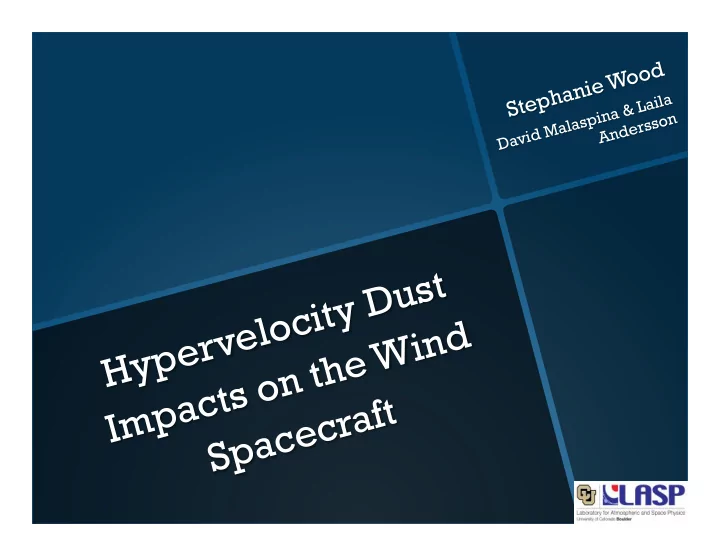

Stephanie Wood David Malaspina & Laila Andersson t s u D y t i c o l e d v n r i e W p e y H h t n o s t c a t p f a m r c I e c a p S
” E } Lots of dust- U S } Not just in Solar System S } Also in Milky Way I “ } What forms galaxies, E H stars, and planets T } Damages spacecraft
} Characterize our D O surroundings (Local H Interstellar Cloud) T } Distinguishing between E M interstellar dust (ISD) from interplanetary dust (IPD) } Relationship between dust and solar cycle
} Gain further E ? W E understanding of our R spot in the galaxy D A L } How the Solar System C U formed O } Exoplanets and stars H S } Knowledge of dust = Y } Prediction of damage to H W spacecraft
W O U N D E D I N T H E F I E L D cometary c o m e t a r y
} Get as much data as I can from Wind T R A } Sift through to find dust P impacts Y M } Determine: } Direction } Flux } Appearance over solar cycle
WHAT IS WIND? } 1994 – Present } Sits at L1 – in front of earth equal gravitational pull from Earth-Sun System } Measures electric field } Original mission: } Study the solar wind before Earth } BUT after damage due to dust hit… } Can better see dust impacts on body } Dust on impact plasma
WHAT IS DUST? } ISD } At 1 AU = ~0.3µm } m ~ 2.8 x 10 -16 kg } IPD } Meteoroids m > 10 -8 kg } β -meteoroids 10 -18 <m<10 -15 kg } Nanodust m < 10 -18 kg
} ISD velocity ~ 26 km/s R } ~20 yrs. to travel Solar S E E System H C } IPD velocity ~ 30 km/s T N O } Charge release is similar E (q r = m/v 3/2 ) R E } Limited by spacecraft F } Saturates at 300 mV/m F I D } Distinguish between IPD and ISD by direction
} Tried to find correlation with interstellar dust (ISD) flux and E D solar cycle W E } Less ISD at solar maximum T T with stronger magnetic fields C A } More ISD at solar minimum E H P W } But with speed of ISD, maybe X just trend over longer time E period } Monthly modulation } Max # ISD impacts in March } Least # ISD impacts in August
} Comes in ascii file A } Electric Field T Measurements A } Taken every 17 ms , 1 D month } Selected by amplitude – ~100 highest amp/day } Convert to idlsave file } FIND DUST!
Accuracy of my dust finding algorithm: 97.6%
H ? T T I A W } Calculate direction and H flux I T O L } Month L D } Year A T A H W
DIRECTION
SUN Y L H T N O v M ISD Direction EARTH
Y E A R L Y
} Not much dust seen until ~2000 H } Still see low point in ‘99 S T E I S W S Y G L N U I H C T A M Kellogg, Paul. University of Minnesota. July 12, 2013.
} Same direction of origin seen Horányi, Mihaly. “iDUST: Dust Tomography of the Heliosphere.” PowerPoint Presentation. Lunar Science Forum. 2011.
ULYSSES TRAJECTORY Horányi, Mihaly. “iDUST: Dust Tomography of the Heliosphere.” PowerPoint Presentation. Lunar Science Forum. 2011.
} Dust modulation seen S per month T } Able to separate IPD/ISD L U component S E } No obvious solar cycle R correspondence } Consistencies between Ulysses and Wind dust measurements
Recommend
More recommend